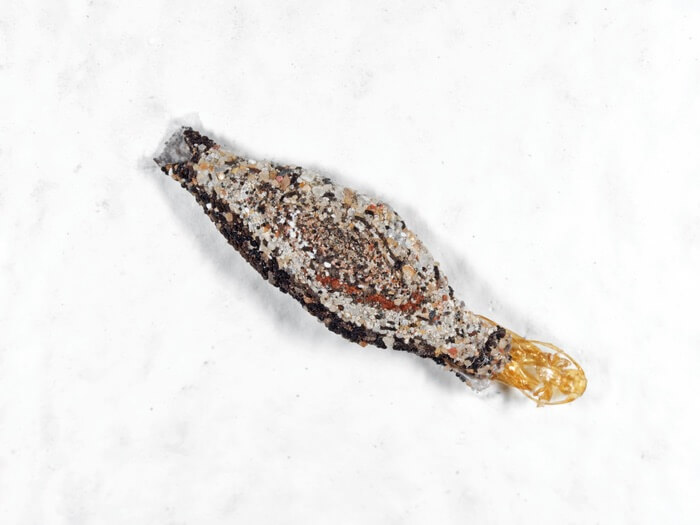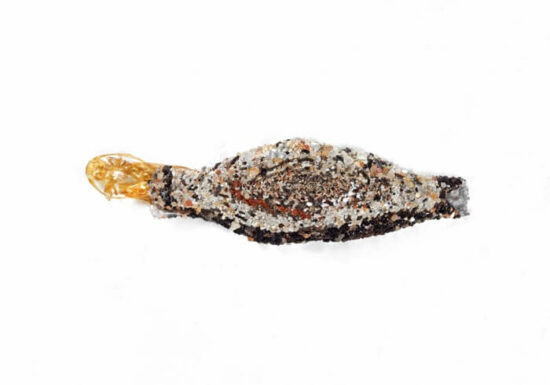If you want to learn how to get rid of plaster bagworms, you’ve come to the right place. While it might not seem complex, there’s a right and wrong way to deal with these insects!
Let’s get started.
Table of contents
What Are Plaster Bagworms?
Plaster bagworms are quirky little pests that can easily go unnoticed. These bugs go by many other names, with some people referring to them as dust worms or household case bearers. Whatever you call them, these insects have several distinct traits.
The most identifying characteristic is the bag for which it gets its namesake! Plaster bagworms live in small, cocoon-like vessels that hang from ceilings and walls. The case is only about half an inch long.
In terms of shape and appearance, it looks pretty similar to a watermelon or pumpkin seed. It’s oval and features a somewhat flat profile, which is perfect for blending into walls. On the top and bottom of the oval-shaped case, there’s a slit-like opening.
- Kills caterpillars and worms
- Convenient hose-end ready to spray
- No effect on birds or beneficial insects
- 32 Fluid Ounces
The cocoon is made up of silk fiber and other organic materials. The insect might use nearby lint, sand, or even dry plaster debris. Either way, the final result is a light gray protective case that hangs discreetly on the walls of your home.

So, what about the actual bug? Curiously enough, plaster bagworms are the larval stage of a moth! The larva, or caterpillar, is rarely seen because it spends most of its time inside that protective casing. However, you might see it peak its head out of one of those slits to eat.
The caterpillar is only about a quarter of an inch long. It’s primarily white and has a brown head. Three sets of legs help the caterpillar walk on horizontal surfaces. Meanwhile, hooked false legs help it turn around inside the casing.
Quick Tip: You’re most likely to encounter plaster bagworms if you live in the Southeastern United States. They’re especially prevalent in the state of Florida. These pests thrive in humid environments. As a result, large populations of plaster bagworms can become a massive problem for Floridians.
Why Do They End Up In Your Home?
Like any other nuisance bug, plaster bagworms move into homes to find food and shelter. Survival is the main priority, and houses provide everything that they need to prosper.
Interestingly enough, plaster bagworms don’t consume food crumbs or leftovers you leave on the kitchen counter. They don’t scavenge for the same things as cockroaches and other common pests, so they’re free to live in their own little bubble undetected.
Plaster bagworms have a diet of wool, spiderwebs, and even the discarded cases of other bagworms. Spiderwebs are some of the most sought-after foods for these bugs, which is why they spend so much energy latching themselves high up on your walls.
The caterpillars will drag their casing along the wall and set up shop near wall corners. You might also find them hanging off of exterior stucco, near outdoor lights, or underneath chairs and benches.
In most cases, plaster bagworms start their life outdoors. They might stay on your exterior door or near a porch light. It’s when they mature into adult moths that they move inside and start a new generation.
- Kills caterpillars and worms
- Convenient hose-end ready to spray
- No effect on birds or beneficial insects
- 32 Fluid Ounces
After a month-long metamorphosis process, the moths will ditch their casing and search for males to mate. The females lay more than 200 eggs in a small, protective casing. The eggs can incubate over the winter before hatching into a large population of young plaster bagworms!
Inside your house, protective cocoons can appear anywhere. From the bottom of furniture to the walls in your closet, bagworms have a knack for showing up in all kinds of oddball locations. Generally, they will stay close to wherever food is near.
Quick Tip: If you have a lot of wool clothing, don’t be surprised if you find them destroying it. Luckily, these bugs will typically leave your cotton and nylon alone.
How To Get Rid Of Plaster Bagworms In Your House
Plaster bagworms are unwelcome guests that can quickly wreak havoc on your home. These bugs often go unnoticed until populations reach massive levels.
Fortunately, getting rid of plaster bagworms is pretty easy if you take the proper steps.
Keep Your Home Cool
One of the most effective ways to get rid of plaster bagworms in your house is to maintain cooler temperatures inside. Remember, these bugs thrive in warm and humid environments. That’s why they’re so prevalent in states like Florida.
If you live in the South, you know the stark difference a powerful air conditioner can make. Walking into a cool home is like stepping into a completely different environment!
If you’re trying to get rid of plaster bagworms, consider cranking up the AC a bit more than normal. Not only will it lower the ambient temperatures inside, but it’ll also continually work to remove moisture from the air. Anything below 75-80 degrees Fahrenheit should be more than enough to deter plaster bagworms from coming in.
If you have a part of your house that’s not insulated or cooled, consider taking steps to change that. Plaster bagworms like to accumulate in garages and attics where most homeowners don’t have proper cooling equipment. Invest in a portable AC, ductless AC, or window unit to keep every inch of your house climate controlled.
Turn Off Outside Lights
Plaster bagworms are so distinct that many people refer to them as a separate entity entirely. However, they’re still larvae destined to become moths.
Moths can’t help but fly towards the light. If you want to prevent these flying insects from laying eggs in or around your house, you’ll need to reduce the lighting outside. Turn off the porch and security lights (especially at night) to ensure that the moths stay away.
Clean & Remove Potential Food Sources
Without any food to survive, plaster bagworms have no choice but to vacate your home and look elsewhere for food. That’s why understanding their main sources of food is so important if you want to get rid of them!
Plaster bagworms mainly survive on wool and spiderwebs.
To address the wool problem, keep all of your items in sealed plastic bags. As mentioned earlier, these bugs don’t eat cotton or nylon. It’s only the wool items you have to protect.
For spiderwebs, clean your house regularly. Take a broom to those high corners near the ceiling. Pay special attention to dusty cabinets and bookshelves. Any place where spiderwebs accumulate will become a feasting ground for plaster bagworms.
Vacuum Regularly
Finally, stick to a routine vacuuming schedule.
When many homeowners see these insects, they’ll instinctively sweep them off the wall and call it a day. However, that’s an ineffective way to get rid of plaster bagworms because it doesn’t address the problem at hand! Even if you sweep away spiderwebs, the bug’s food source only ends up on the floor.
The best course of action is to vacuum everything. Use your machine’s attachments to suck up spiderwebs and plaster bagworm sacs as you see them.
Quick Tip: Don’t forget to empty the bag or canister to ensure that the pests are out of your house for good!
Are They Dangerous?
Plaster bagworms aren’t inherently dangerous. They don’t bite or cause any physical pain if you touch them.
That said, these bugs can cause a lot of damage around your house. Plaster bagworms can destroy pricey wool and natural-fiber items. While they might be small, a large population can wreak havoc on all of your prized garments.
If you suffer from allergies, the mere presence of these bugs can cause problems as well. They’re not as bad as dust mites and cockroaches, but allergy-sufferers can still feel the effects of their presence.
Once the caterpillar becomes a moth, these bugs can create even more issues. The life cycle can continue until you have thousands and thousands of plaster bagworms to get rid of. At that point, the potential damage caused by these bugs is outstanding.
Plaster bagworms might not bite, but they’re certainly not a pest you should ignore.
Closing Thoughts
Now that you know how to get rid of plaster bagworms, it’s time to put in the time to reclaim your home. These funky insects can be quite annoying, but aren’t too difficult to handle as long as you take the right approach.
If you have a particularly challenging plaster bagworm problem and want some advice, send us a message. We’re happy to help.



